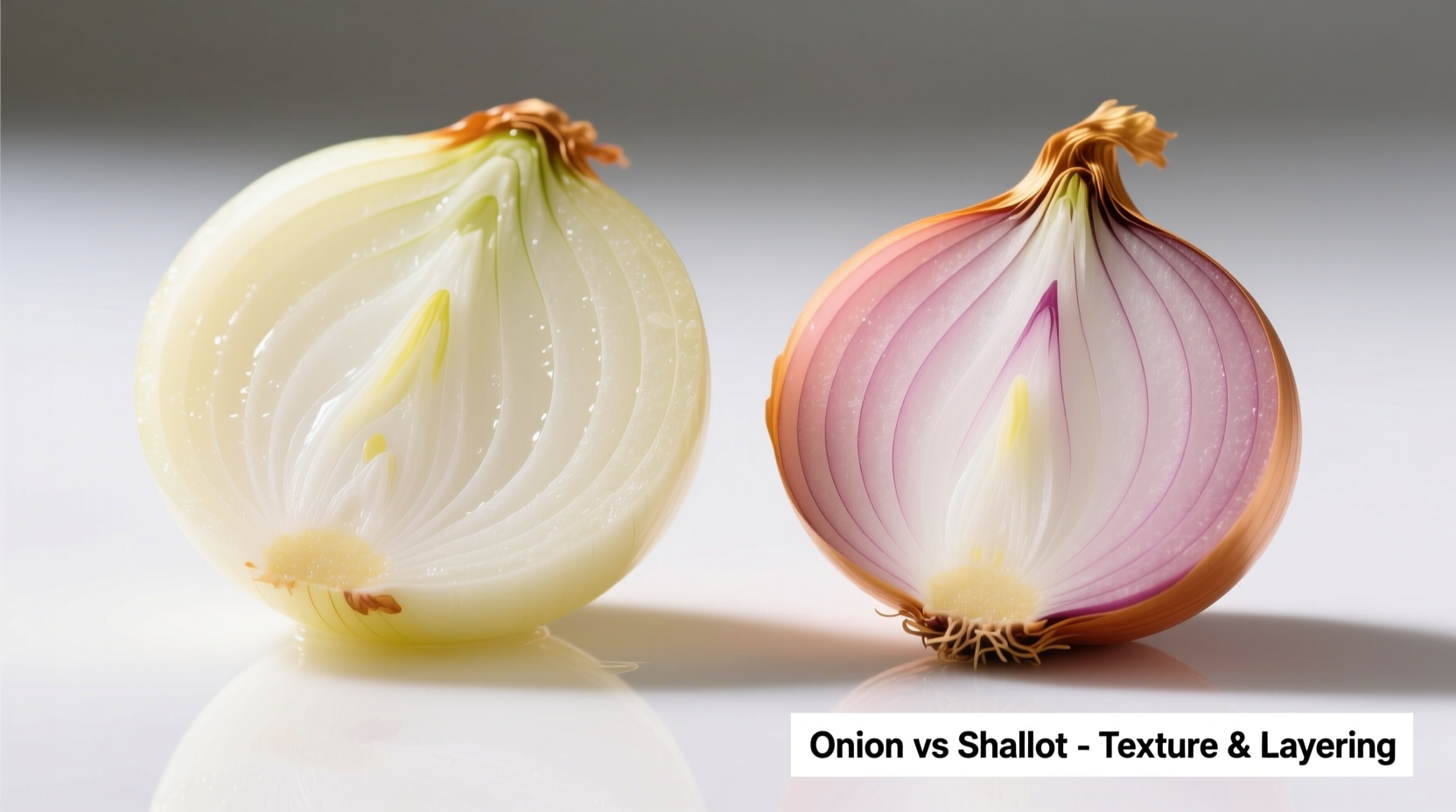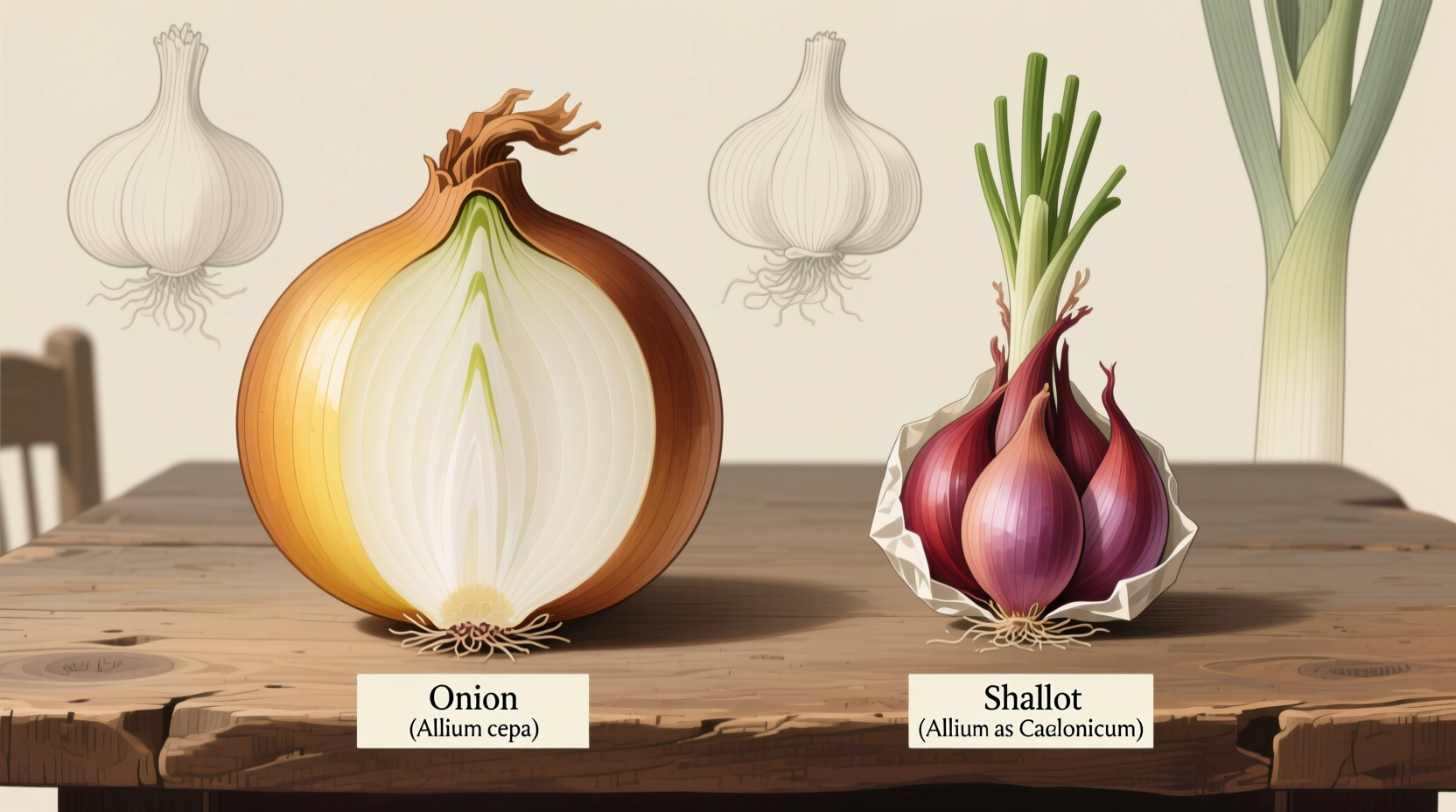Understanding the distinction between these two allium varieties can transform your cooking. Many home chefs mistakenly treat them as interchangeable, but their unique properties make each better suited for specific culinary applications. Let's explore exactly how these kitchen staples differ and when to choose one over the other.
Botanical Classification: More Than Just Different Names
Despite their similar appearance, onions and shallots belong to different botanical classifications. Common onions (Allium cepa) develop as single, large bulbs with concentric layers. Shallots (Allium oschaninii or sometimes classified as Allium cepa var. aggregatum) grow in clusters of multiple bulbs, each with its own papery skin.
This fundamental difference explains why shallots often have a more complex flavor profile. The clustered growth pattern affects their sugar concentration and sulfur compounds, resulting in their distinctive taste characteristics.
| Characteristic | Onion (Allium cepa) | Shallot (Allium oschaninii) |
|---|---|---|
| Botanical Type | Single bulb variety | Cluster-forming variety |
| Genetic Makeup | Diploid (16 chromosomes) | Tetraploid (32 chromosomes) |
| Common Varieties | Yellow, red, white onions | French gray, Jersey, Egyptian |
| Harvest Season | Late summer to fall | Mid to late summer |
Flavor Profile Comparison: Why Chefs Choose One Over the Other
The most significant practical difference lies in their flavor chemistry. Onions contain higher levels of sulfur compounds, giving them that characteristic pungency that mellows when cooked. Shallots have approximately 70% less sulfur than yellow onions, resulting in a more delicate flavor with subtle garlic notes.
According to research from the USDA Agricultural Research Service, shallots contain higher concentrations of certain flavonoids, particularly quercetin, which contributes to their slightly sweeter profile. This chemical difference explains why professional chefs often reach for shallots in applications where raw onion would overpower other ingredients.

Culinary Applications: When to Use Each Allium
Understanding the context boundaries for each variety helps maximize their potential in your cooking:
Best Uses for Onions
- Caramelizing (yellow onions develop beautiful sweetness)
- Hearty soups and stews (where strong flavor is desired)
- Salsas and relishes (when you want pronounced onion flavor)
- Grilled applications (hold their structure well)
Best Uses for Shallots
- Vinaigrettes and delicate sauces (like beurre blanc)
- Raw applications in salads and garnishes
- Fine dining reductions (where subtle flavor is key)
- Asian cuisine (particularly in Thai and Vietnamese dishes)
As noted in "On Food and Cooking" by Harold McGee, a culinary science authority, "Shallots' milder flavor makes them preferable when raw, while their higher sugar content allows them to caramelize more quickly than onions." This scientific insight explains why many French chefs exclusively use shallots for raw applications.
Substitution Guide: Making the Right Swap
When a recipe calls for one but you only have the other, understanding proper substitution ratios is crucial:
- 1 small shallot ≈ ½ small yellow onion (but expect stronger flavor)
- 3 shallots ≈ 1 medium onion in volume
- When substituting onions for shallots, reduce quantity by 30-50% to avoid overpowering dish
- For raw applications, soak chopped onion in cold water for 10 minutes to reduce pungency
Professional chefs often recommend keeping both varieties on hand, as they serve different purposes in the kitchen. "Think of them as different instruments in an orchestra," explains Antonio Rodriguez, chef and culinary educator. "You wouldn't use a tuba when you need a violin's delicate sound."
Nutritional Comparison: Health Benefits Compared
Both alliums offer impressive nutritional profiles, but with some notable differences:
| Nutrient (per 100g) | Yellow Onion | Shallot |
|---|---|---|
| Calories | 40 | 72 |
| Carbohydrates | 9.3g | 16.8g |
| Dietary Fiber | 1.7g | 3.2g |
| Vitamin C | 7.4mg | 15mg |
| Quercetin | 19.3mg | 34.5mg |
Data from the USDA FoodData Central shows that shallots contain nearly twice the quercetin of yellow onions. Quercetin, a powerful antioxidant, contributes to many of the health benefits associated with allium vegetables. Both varieties support cardiovascular health and contain compounds with potential anti-cancer properties.
Storage Differences: Maximizing Shelf Life
Proper storage significantly impacts how long these alliums maintain their quality:
- Onions: Store in cool, dry, dark place with good air circulation; can last 2-3 months
- Shallots: Require similar conditions but have shorter shelf life (about 1-2 months)
- Never refrigerate whole bulbs (causes moisture buildup and spoilage)
- Once cut, both should be stored in airtight container in refrigerator for 7-10 days
The National Onion Association notes that shallots' clustered structure makes them slightly more perishable than single-bulb onions. Their multiple contact points create more opportunities for moisture retention and spoilage.
Common Misconceptions Clarified
Several myths persist about these allium varieties:
- Myth: Red onions are just colored shallots
Fact: Red onions are a variety of Allium cepa with different genetics than shallots - Myth: Pearl onions are baby shallots
Fact: Pearl onions are immature Allium cepa bulbs, not related to shallots - Myth: Shallots are always more expensive because they're superior
Fact: Higher cost stems from lower yields and more labor-intensive harvesting
Understanding these distinctions helps you make informed choices at the market and in your cooking. The price difference primarily reflects agricultural factors rather than inherent superiority of one variety over the other.
Practical Takeaways for Home Cooks
Here's how to apply this knowledge immediately:
- For salad dressings and vinaigrettes, always choose shallots for their delicate flavor
- When making French onion soup, yellow onions provide the necessary robust flavor
- For raw applications like pico de gallo, soak onions in cold water to reduce harshness
- When substituting, remember that shallots cook faster due to higher sugar content
- Store both varieties in mesh bags for optimal air circulation
Mastering these subtle differences between onions and shallots will elevate your cooking from good to exceptional. The right choice of allium can transform a dish from merely tasty to perfectly balanced.











 浙公网安备
33010002000092号
浙公网安备
33010002000092号 浙B2-20120091-4
浙B2-20120091-4